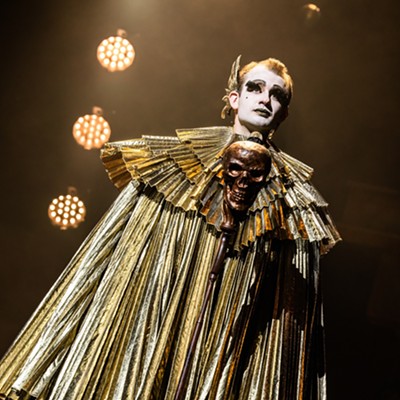Tuesday, March 18, 2014
More on Astria Suparak and CMU’s Miller Gallery
Carnegie Mellon University has yet to announce detailed plans for the Miller Gallery, whose course abruptly shifted in January, when the school parted ways with longtime director Astria Suparak.
CMU spokesperson Pam Wigley says a faculty committee is currently meeting about how to advance the school’s decision to turn the on-campus art gallery into what an earlier statement described as a “combined gallery, teaching and research space that includes space for installations, seminars, hands-on art-creating workshops, artist lectures, and applied research in curatorial/exhibition practices.” Wigley says a formal update is expected by the end of March.
Meanwhile, questions about Suparak’s termination linger: Many in the art community don’t understand why a cutting-edge gallery director who spent six years boosting attendance and drawing rave reviews for exhibits that often went on to tour nationally isn’t still working there.
Suparak isn’t talking to the media about her departure, and CMU declines to discuss personnel matters. But others close to the school and the gallery tell CP there were issues at play beyond the attention Suparak and the Miller drew.
On campus, for instance, critics faulted Suparak’s curatorial approach. For some tastes, too many of her exhibits relied too heavily on texts, documentary photos and natural-history-museum-style display cases, rather than on paintings, sculpture or even installation works.
“Artistically, I felt it was a pretty narrow perspective,” says one CMU faculty member who asked to remain anonymous. The faculty member generally supported Suparak’s approach, but said, “The actual nature of the work, there is a kind of monotony to it. I think people were getting frustrated with that.”
Suparak’s shows often presented documentation — like the photos of research projects in Intimate Science — or artifacts of a subculture, like the home-made concert posters and slogan-bearing T-shirts in Alien She. Students and professors visiting a campus-based gallery “need work that engages more with the materiality of media,” said the faculty member.
Put another way, “People who make more traditional objects were feeling left out,” says one of Suparak’s art-community colleagues.
Some observers have also noted dissatisfaction with the frequency of the shows. The Miller occupies its own spacious, three-story building, but in recent years Suparak had staged only one or two new full-scale exhibits a year (not counting the two longstanding annual showcases for the university’s BFA seniors and its MFA graduate students). In the years before Suparak’s arrival, the Miller had typically hosted at least four exhibits a year.
“For the budget, for the staff, for our status, I don’t think that we had enough programming,” said the CMU faculty member.
Meanwhile, although attendance at the gallery increased under Suparak, especially for the big opening events, it might not have been enough for CMU officials. “They wanted those numbers to be higher,” says CMU art professor Richard Pell, a member of the gallery’s advisory committee. (For his part, Pell laments Suparak’s departure: “It seems really shortsighted, with what she’s done,” he says.)
Personality might have played a role in Suparak’s departure as well, some surmise: “stubborn” and “uncompromising” are two terms often used to describe Suparak at work. And while her supporters point out that such qualities are often viewed as positive traits in leaders — especially if those leaders are men — they acknowledge that she’s scarely the back-slapping, go-along-to-get along type. “She’s not easy to know, and in some ways it’s a who-you-know town,” says one such supporter. “She’s not gonna be the compromiser in the room. And it irritates some people.”
But in the wake of Suparak’s departure, the overriding sentiment remained shock that she is gone.
Hilary Robinson, a former dean of CMU’s College of Fine Arts and the person who hired Suparak, says that in 2008, the Miller was “moribund” — little known off campus and running a deficit. Robinson, interviewed in February, says she gave Suparak three years to turn the gallery around, and “she rose to that challenge. … She got back on budget, and she made the place known. … Astria Suparak made it a place people wanted to go.”
The shows remain popular elswhere, too. Intimate Science, a 2012 exhibit at the Miller, is still touring; it opened Feb. 6, at New York City’s Sheila C. Johnson Design Center, part of Parsons The New School for Design. Alien She, the final exhibit Suparak presented (and co-curated) at the Miller, just opened at Philadelphia’s Vox Populi.
But those tours might not have helped Suparak’s status with CMU officials. “As far as I can tell … the touring exhibitions and the amount of visitors they attracted didn’t seem to calculate into their statistics,” Pell says. He noted the big February opening reception in New York for Intimate Science, which he attended because it included contributions by his Center for PostNatural History. “The amount of attention that show received in Manhattan is huge. We can’t get that kind of a crowd here.”
Robinson, who left CMU in late 2012 to return to Great Britain, notes that in 2012, Suparak was one of 15 nominees in the world for Independent Curators International’s Independent Vision Curatorial Award, for mid-career curators. (Other nominees included Jay Sanders, of the Whitney Museum of American Art.)
“If that was a faculty member [who’d been nominated], they’d be saying ‘This is good for your tenure case,’” says Robinson.
Robinson said it was ironic that CMU planned to turn the Miller into a space focused on the needs of students and instructors. “Where else in Carnegie Mellon would a school say, ‘We’re going to look more inwardly’ and get praised for it? Absolutely nowhere. … Everyone would fall ’round laughing.”
Indeed, even the Miller Gallery itself continues to tout Suparak’s impact. Weeks after her final day at work, on the closing weekend of her final exhibit at the Miller, clippings still posted on a bulletin board outside the gallery announced her successes over the years. Postings visible Feb. 15 included coverage in The New York Times and the Huffington Post; that final show, the riot-grrrl-themed Alien She, was a critic’s pick in ArtForum.
As of last week, the Miller Gallery’s website included this testimonial from Nicolas Lampert, a senior lecturer at the University of Wisconsin-Milwaukee’s Pect School of the Arts: “Suparak and her staff have set the bar for contemporary art exhibitions about art and social justice. My message to artists and art students seeking inspiration in the US: look first at Pittsburgh and the Miller Gallery, then look at NYC, LA and Chicago.”
That endorsement seems to have since been removed.
Tags: Astria Suparak , Miller Gallery , Carnegie Mellon University , Alien She , Intimate Science , Richard Pell , Hilary Robinson , Program Notes













